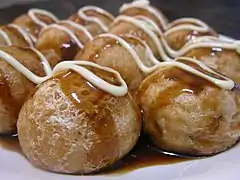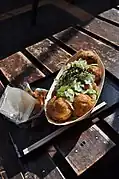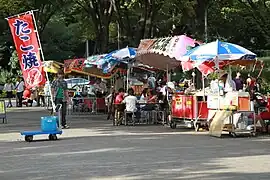 A "boat" of takoyaki | |
| Course | Snack |
|---|---|
| Place of origin | Japan |
| Region or state | Osaka |
| Main ingredients | Batter, octopus, tempura scraps (tenkasu), pickled ginger, green onion, takoyaki sauce (with mayonnaise), green laver (aonori) |
| Variations | Taiwanese cuisine |
Takoyaki (たこ焼き or 蛸焼) is a ball-shaped Japanese snack made of a wheat flour-based batter and cooked in a special molded pan. It is typically filled with minced or diced octopus (tako), tempura scraps (tenkasu), pickled ginger (beni shoga), and green onion (negi).[1][2] The balls are brushed with takoyaki sauce (similar to Worcestershire sauce) and mayonnaise, and then sprinkled with green laver (aonori) and shavings of dried bonito (katsuobushi).
Yaki comes from yaku (焼く), which is one of the cooking methods in Japanese cuisine, meaning 'to grill', and can be found in the names of other dishes in Japanese cuisine such as okonomiyaki and ikayaki (other famous Osakan dishes).[3] Typically, it is eaten as a snack or between meals, but in some areas it is served as a side dish with rice. It is an example of konamono (konamon in the Kansai dialect), or flour-based Japanese cuisine.
History
Takoyaki was first popularized in Osaka,[4] where a street vendor named Tomekichi Endo is credited with its invention in 1935. Takoyaki was inspired by akashiyaki, a small round dumpling from the city of Akashi in Hyōgo Prefecture made of an egg-rich batter and octopus.[5] Takoyaki was initially popular in the Kansai region, and later spread to the Kantō region and other areas of Japan. Takoyaki is associated with yatai street food stalls, and there are many well-established takoyaki specialty restaurants, particularly in the Kansai region. Takoyaki is now sold at commercial outlets, such as supermarkets and 24-hour convenience stores.[6]
It is also very popular in Taiwanese cuisine due to the historical influence of Japanese culture.[7]
The oldest known takoyaki store is Aizuya in Osaka. Founded by Tomakichi Endo, it has been open since the 1930s. The first takoyaki included beef and konjac, but later Endo switched to using the now traditional octopus and added flavor to the batter. The takoyaki are then eaten with brown sauce, similar to Worcestershire sauce. In recent years, takoyaki can be eaten with various toppings and fillings (such as cheese or bacon[8]) as its cultural span has evolved in western parts of the world. The food, known as "octopus balls", quickly became popular throughout Japan.[9][10]
Takoyaki pan
A takoyaki pan (たこ焼き器, takoyaki-ki) or—much more rarely—takoyaki-nabe (たこ焼き鍋) is typically a griddle made of cast iron with hemispherical molds, similar to a traditional Yorkshire Pudding tray.[2] The heavy iron evenly heats the takoyaki, which are turned with a pick during the heating process to pull the uncooked batter to the base of the rounded cavity. Commercial gas-fueled takoyaki cookers are used at Japanese festivals or by street vendors. For home use, electric versions resemble a hotplate; stovetop versions are also available, and many incorporate a non-stick coating to facilitate turning.
In popular culture
A children's book named Takoyaki Mantoman, published in the 1990s and later adapted into an anime television series produced by Studio Pierrot that aired from April 1998 to September 1999, focuses on a group of takoyaki fighting crime.
In the Animal Crossing series of video games, there is a villager named Zucker, based on takoyaki. He is an octopus with a round head resembling takoyaki, he generally wears a yukata, and his home is inspired by a traditional Japanese summer festival.
An Internet meme originating from the Philippines showcases a variation of the food in a viral video with the phrase, "Nakatikim ka na ba ng tig-dalawang pisong takoyaki?", meaning "Have you ever tried the "two-peso takoyaki"?". Even though the food showcased in the video does not contain any octopus, the uploader continues to describe it as such thus resulting into many variations of the meme.[11]
Image gallery
 Cooking takoyaki
Cooking takoyaki Takoyaki served with Japanese Worcester sauce and mayonnaise
Takoyaki served with Japanese Worcester sauce and mayonnaise
 A takoyaki yatai in Yoyogi Park, Tokyo
A takoyaki yatai in Yoyogi Park, Tokyo Square takoyaki pan with 16 molds
Square takoyaki pan with 16 molds.jpg.webp) Open kitchen store
Open kitchen store
See also
References
- ↑ "蛸焼" [Takoyaki]. Dijitaru daijisen (in Japanese). Tokyo: Shogakukan. 2012. OCLC 56431036. Archived from the original on 2007-08-25. Retrieved 2012-06-22.
- 1 2 "Takoyaki". Encyclopedia of Japan. Tokyo: Shogakukan. 2012. OCLC 56431036. Archived from the original on 2007-08-25. Retrieved 2012-06-22.
- ↑ Takiyaki, the great street snack
- ↑ "蛸焼" [Takoyaki]. Nihon Kokugo Daijiten (in Japanese). Tokyo: Shogakukan. 2012. OCLC 56431036. Archived from the original on 2007-08-25. Retrieved 2012-06-17.
- ↑ Takoyaki - Icon of Osaka
- ↑ "Takoyaki | food | Culture | Japan Dream Tours". japandreamtours.com. Retrieved 2019-10-16.
- ↑ "In Taiwan, top chefs are building on a long history of culinary exchange with Japan", The Japan Times. Retrieved 2018-02-28.
- ↑ Chen, Namiko (2016-12-05). "Takoyaki Recipe (Video) たこ焼き". Just One Cookbook. Retrieved 2022-07-14.
- ↑ "【飲食籽】快閃大阪 嘆米芝蓮章魚燒". Apple Daily 蘋果日報. Retrieved 2019-03-07.
- ↑ "可愛章魚小丸子". 太陽報 (in Chinese (Hong Kong)). Retrieved 2019-03-07.
- ↑ Reyes, Lora (10 December 2022). "The memes behind this vlogger's '2-peso Takoyaki' food review are flooding the Internet". Pop Inquirer. Retrieved 15 December 2022.
External links
- Making Classic Takoyaki at Home A DIY Takoyaki recipe.
